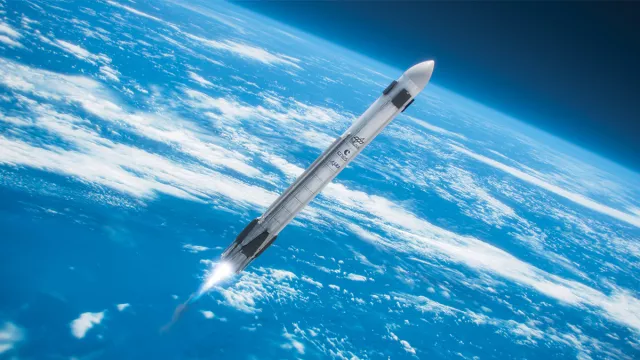Callisto is a fully reusable 13-metre-high launch vehicle scheduled to make its first test flight from the Guiana Space Centre in 2026, climbing to an altitude of about 20 kilometres and then returning to Earth.
Key information
| Mission | Test a vertical-landing reusable launcher first stage |
|---|---|
| Domain | Space transportation |
| First flight | 2026 |
| Partners | DLR, JAXA |
| Where | Guiana Space Centre |
| Lifetime | Indefinite |
| Status | In development |
Key figures
- 13 metres tall
- 10 test flights planned
- 46 kN of thrust
- 1.1-metre span
Key milestones
- 2026: First planned test flight
- 2025: Vehicle integration in Japan
- Late 2024: End of detailed design phase
- Late 2019: End of preliminary design phase
- 2017: Partners JAXA and DLR join project
- Late 2015: Project kicked off in house at CNES
Project in brief
Reusability—launching a vehicle, bringing it back to Earth and then sending it into space again—was partly accomplished in the 1980s with the U.S. Space Shuttle and is today a possible way forward for the space industry. For now, only U.S. launch providers Blue Origin and SpaceX have chosen to go down this route, with considerable success. The concept’s main advantage is that it reduces launch costs, which is why customers are turning to these firms.
CNES has been working on reusability concepts since the 1980s, and its efforts have finally resulted in a real-world demonstration after deciding in 2017—after an initial in-house study phase—to launch a project with its international partners to trial a small, fully reusable spacecraft called Callisto.
Standing for “Cooperative Action Leading to Launcher Innovation in Stage Toss-back Operations”, Callisto is a project being pursued with the Japan Aerospace Exploration Agency (JAXA) and the German space agency DLR. A large number of international contractors are also contributing to the experiment, among them ArianeGroup and Mitsubishi Heavy Industries.
Callisto is a demonstrator designed to conduct flight testing and mature the complex technologies required to return a launcher to Earth, as well as refurbishment operations between flights, and to precisely cost an operational European launcher with a reusable first stage (it is not intended to become an operational launcher).
Standing 13 metres tall and with a diameter of one metre, Callisto is powered by a reusable cryogenic engine burning hydrogen and oxygen supplied by JAXA. This engine is able to throttle from 16 to 46 kN and is reignitable in flight.
Flights will be conducted from the Guiana Space Centre’s Diamant launch site, which is itself being refurbished and re-used for the project. This site is where the Diamant B launcher was operated from in the 1970s.
Callisto’s maiden flight in 2026 will be the first in a series of ten test flights.
The Diamant site will also subsequently accommodate European micro-launcher flights.
CNES’s role
CNES is in charge of architecture studies for the launch system, vehicle system and ground segment.
CNES contacts
Project Leader
Michel Illig
E-mail: michel.illig at cnes.fr
Project Communication Officer
Thomas Lienart
E-mail: Thomas.Lienart at cnes.fr
Project news



